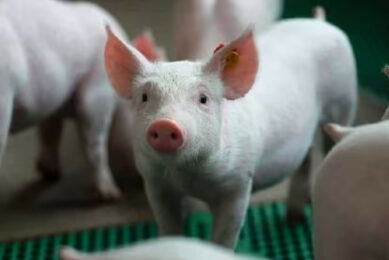A revolution in thinking about pig tails

Industry-wide agreements in the Netherlands are likely to be the first step in a process to phase out tail docking. The underlying problem of tail biting, however, is not solved by banning ?docking. Now more than ever, thinking about pig tails is taken ?seriously.?
Multifactorial – there is no truer word than this when referring to tail biting. Some pork producers say it is a draught problem; others say it’s the change of the seasons; others again are sure it is all down to changes in feeding patterns and a fourth group may be convinced the runts are to blame. No two pork producers may say the same – making it extremely difficult to really figure out what causes the problem.
Even when pigs are docked, which is currently mainstream practice in most pig production all over the world, tail biting occurs. Research in the Netherlands pointed to an annual cost loss of about €8 million for the Dutch pork industry alone – and the problem is found in 2.1% of all pigs produced.
Apart from the health problem, over the years, pig tails have also become the centre of a welfare debate. Increased criticism can be heard about the practice of tail docking, especially in North West Europe. Tail docking, usually within four days after birth, is increasingly considered to be a cruelty.
In short: Tail biting has always been a problem – and now its (partial) solution is too. The time has come for some fundamental re-thinking – here’s what has been happening in the Netherlands.
Breeding approach
Pivotal in the thinking around tail biting and tail docking in the Netherlands is Wageningen University. In this context, it is worth mentioning the research project ‘Seeking Sociable Swine’. The project, having a scope that is wider than only tail biting, was jointly set up with VU University Amsterdam and the Topigs Research Center IPG.
The four-year project aims to discover how pigs could be influenced to behave more socially. Four PhD students have been working on this project – Naomi Duijvesteijn, Inonge Reimert, Marianne Benard and Irene Camerlink, animal scientist, who is also the spokesperson for the project. She describes social pigs as pigs having a positive impact on their group mates.
Camerlink herself studied whether it is possible to select for the trait of having a positive influence on group members, possibly due to being social. In terms of humans one could say that there are always people who give each other positive or negative energy for various reasons – and Dutch breeder Topigs suspected something similar could be the case in pigs.
Earlier work by Dr Piter Bijma and others, published in 2007, already focused on genetic selection based on ‘relatives’. So what ‘indirect genetic effects’ could be found after this kind of selection?
Assigning social breeding factors to pigs in a reproduction programme, Camerlink noticed that selection for a high social breeding value in combination with growth per day coincided with a reduction in biting incidents, in particular tail biting.
Another area studied in the Sociable Swine project indicated that the social pigs showed less aggressive biting behaviour. Besides genetics, environment proved to have a strong impact on the social behaviour of pigs. Pigs in barren pens simply had nothing to do – leading to boredom and biting behaviour. On the contrary, pigs on straw did not appear to bother their pen mates as much.
Bucket of problems
The more research is being carried out on tail biting – the more is known, but exact causes and effects still need more research. Camerlink says, “The basis of the problem of tail biting is determined by a good pig health.”
In graphic presentations by Wageningen University, the problem is usually presented by showing a bucket which is full of ‘problems’, see Figure 1. Basic content of the bucket is made up of boredom – defined as the absence of distraction material.
This is then topped by elements like feeding, surroundings, climate, health and animal related factors. When all these other elements are reasonably under control, tail biting may not prove to be a problem in a pig house. Should one condition, however, be disproportionately worse than the rest, then pigs may get into a stress situation. Those pigs suffering from the worst health – usually the smaller ones – will be the first ones which may ‘translate’ their stress behaviour into tail biting. In the bucket analogy – this is the moment when it is toppled over, and contents spill out onto the floor. Once one starts tail biting, others will follow – and an outbreak is the result.
Camerlink says, “The problem appears to occur particularly in pigs from six to eight weeks. Distraction material may therefore hang in pig houses for a long time without being touched, but as soon as a stressful situation sets in, through whatever cause, this is when we need to have distraction material ready for them to chew on, like e.g. some straw or wood.”
The research group extended its knowledge in various sessions with pork producers as well as with leading companies in the industry, including pig breeder Topigs and animal feed company Coppens. Camerlink says, “Just informing producers and the industry about scientific results may not always prove enough. What we need is an interactive dialogue between stakeholders, including scientists and farmers, to equally exchange knowledge between science and practice. This is also the case for solving problems around tail biting.”
Some practical advices they gave can be found in the box Tail biting: Some do’s and don’ts.
Future
With regard to one of the comments in the box – don’t wait until the future takes over – the urgency could not become much clearer in the Netherlands. In early June, the Dutch pig industry jointly and voluntarily agreed to eventually put a stop to tail docking. In other words, for producers it is no longer ‘interesting’, but ‘necessary’, to zoom in on potential causes of tail biting and provide ways to avoid it.
The declaration was set up by a Dutch task force, monitored by – again – Wageningen University, and is uniting many stakeholders in the Netherlands’ pig industry. This included the Dutch Agri- and Horticultural Organisation (LTO), the Dutch union of pig producers (NVV), the Dutch animal welfare organisation, veterinarians, breeding companies, meat packers, animal feed industry and the Dutch authorities. The declaration has been offered to the Netherlands Ministry of Economic Affairs.
The partners emphasised that putting a stop to tail docking comes with conditions. It should happen gradually, happen in the long term, and only if alternatives offer sufficient perspectives. Money should therefore be made available for more research as well as for initiatives that can help producers accelerate the stopping of the practice.
As proposed by a leading pork producer, one practical example could be to dock a little bit but not most of the tail. Various other practical steps agreed included the set up of a demonstration project under field conditions at the Pig Innovation Centre in Sterksel, the Netherlands. This project will take into account the latest worldwide knowledge, focusing on good management and minimal adaptations to the pig house. Developing networks as well as a practical tool kit are also part of the road map – and potentially convincing other European countries as well to follow these steps.
Are the Sociable Swine project as well as the declaration the first and most difficult steps on a road to the future? Or are these steps on a road to nowhere? An answer is hard to give. What is clear, however, that a multifactorial problem requires finding a solution that is equally interdisciplinary. Exactly that is what appears to be happening right now.
Pig Progress Volume 29.6 2013
Tail biting: Some do’s & don’ts
The research group Sociable Swine gave six ideas on how to be better armed as a producer for a tail biting problem:
– Be alert whenever there is change in a pig house;
– Pay attention to restlessness and the hanging of tails or tails between legs – these are early indicators of tail biting;
– Don’t wait until things go wrong as biting seems ‘contagious’;
– Make sure a back up plan is in place;
– Invest in becoming alert;
– Start trying to minimise tail docking before legislation forces you to.
And what to do when there is a tail biting problem in a pig house?
– Provide distraction material, especially in weeks 7 and 8 of life;
– Remove the biter – this one should be relatively easy to trace;
– Discuss potential solutions with colleagues, advisors and vets;
– Be ready once it occurs.
In case the problem is in its escalating phase, advice:
– Spray all animals in the pen using a iodine solution as pigs don’t like it – and it works like a disinfectant;
– Remove biters if possible;
– Remove victims if possible;
– Treat the wounded tails;
– Make sure an infimary is available.











